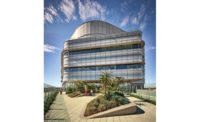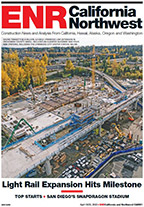

In the first of a series of seismic shake-table tests to gauge the effects of major earthquakes and fire on a hospital’s non-structural components and systems, a five-story specimen and its contents came through with flying colors. The excellent performance on April 17, attributed to the specimen's base-isolation system, came as no surprise to researchers at the University of California, San Diego, who are conducting the tests.
The tests simulated shaking from the 1994 magnitude-6.7 Northridge, Calif., quake and the 2010 magnitude-8.8 San Pedro temblor in Chile. “The test was really a success in the sense that the base isolators protected the non-structural components from the damaging effects of the ground motion,” says Tara Hutchinson, a professor of civil engineering at UCSD’s Jacobs School of Engineering and the lead principal investigator of the tests, which were performed at the Englekirk Structural Engineering Center at UCSD. “Had this building been occupied, it would remain operational,” she said.
From the initial results, the base-isolation system performed “well beyond our expectations, though we thought we’d have more deflections inside the building,” adds Jose Restrepo, the co-principal investigator, structural system, at UCSD and designer of the base-isolation foundation. “You always expect a better performance with base isolation, even though it’s more expensive.”
“When you look at the interior, only the very low-resistance contents, such as rolling patient beds or rolling carts, are really impacted by such low-acceleration demands,” says Hutchinson. “That’s the beauty of this kind of test—it provides you the opportunity to show the success of strategies such as base isolation.”
Restrepo says the specimen, which was designed by Robert Englekirk, chairman emeritus of Englekirk Partners, Los Angeles, and financial supporter and researcher at the center named after him, measures 20 ft by 45 ft and rises five levels, including the rooftop systems. He says the lateral-force resisting system chosen for the building is a reinforced-concrete moment-resisting frame, which commonly is found in California.
The specimen is outfitted with hospital services, such as an intensive-care unit and surgery suite, mounted on a high damping rubber isolator. Restrepo says the test also monitored motion effects on two kinds of facade: the two top floors consist of heavy precast-concrete panels and the three lower floors are covered with flexible metal studs overlaid with gypsum board and lightweight stucco.
This test was the first time in the U.S. that a base-isolation system was interrogated under a full-scale building on a shake table, and it was the first time that tests focused on a broad range of non-structural systems and equipment, says Restrepo. (In 2007 and 2008, Japan’s Hyogo Earthquake Engineering Research Center conducted similar tests. However, says Restrepo, “The tests carried out recently in San Diego have added complexity and all components have been outfitted by U.S. contractors to meet U.S. standards.”)
Installed in and around the building are a variety of non-structural components and systems (NCSs), such as a functioning elevator, stairs, medical and computer equipment, ceilings, a working electrical system, fire barriers and a charged sprinkler system, Hutchinson says. The exterior includes heavy precast-concrete cladding as well as synthetic stucco. Mounted on the roof are a penthouse, a large water tower and an air-handling unit.


